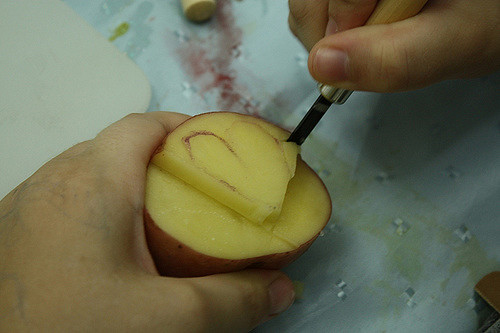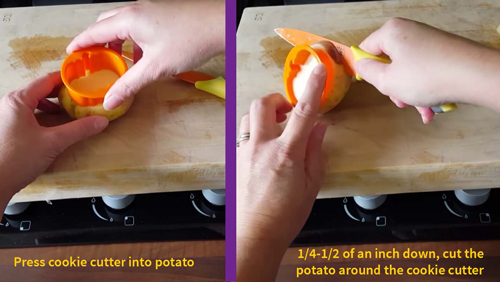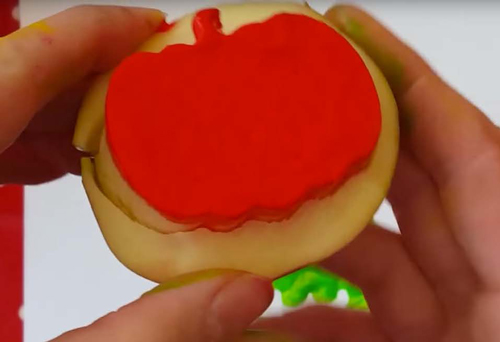Printing Press Inquiry Unit
(Alternate Formative Performance Task, Supporting Question 1)
Potato Stamp Monogram
Create a pad of personally monogrammed writing paper in the style of Gutenberg printing. Use potatoes to carve character blocks and some version of an ink ball to apply ink to the raised characters. Finally, use glue and/ or string to bind the pages together. Goal is for students to make each page the same.
Learning Outcome:
Create an experience for students, which will allow them to understand the importance of the invention of movable type, its use in Gutenberg’s printing press, and its affect on the mass dissemination of information.
Materials
- Idaho Potatoes (One for every 2 students; potatoes will be cut in half)
- Kitchen knife (to cut the potatoes in half)
- Stencil of script letter (first letter of first or last name of each student; appropriate size to fit within potato) or basic shape cookie cutters (circles, squares, etc)
- Sharpie/Permanent marker
- Small knife, that won’t slip easily and a potato peeler (The end of the potato peeler may be used to scoop out the letter design. Be sure to either wrap the razor edges of the potato peeler with lots of tape, or ensure the students don’t hold the peeler by the razor edge!) You could also use cookie cutters for the base of the letter design, rather than using knives and cutting tools in the classroom, if you choose this route, the students will then have to create the letter with markers to make it look like a letter (In this instance you will also need markers). In this video Martha Stewart shows how to make potato stamps with cookie cutters. http://www.marthastewart.com/919982/how-make-potatostamps
- Have each student bring in a pair of safety gloves, or provide one for students to share
- Large ink pad (big enough to fit raised characters) or paint
(Optional- get different color inks or paints to enable another aspect of personalization) - Small stack of blank paper for each student
(Optional- get beige or brown paper for an authentic look) - 3- or 1-hole punch
- String/Ribbon or glue to bind pages together
Instructions
(Students will be cutting with either a knife or with another cutting tool. Please preface extreme caution and care be used to prevent any injuries.)
- Gather your materials.
- Cut the potatoes in half and distribute to students, each student gets one half.
- Place the cutout of the script letter on the potato.
A. Note: Some letters may need to be placed in reverse so they will transfer correctly, such as S, K, J, P, etc. - Trace the letter with a marker.

- Carefully cut away the potato on the outside of the letter in such a way that the letter will be raised enough to act as a stamp.
A. Have students use gloves for safety, and use extreme caution and care with the cutting tool.
B. Alternatively, you can use a cookie cutter as a base template, and have students cut their letter out.

- Using the ink pad or paint, apply ink to the raised character.
A. Note this process is very similar to how ink balls were used to apply ink to typeset with historic printing presses, such as with the Gutenberg printing press.

- Apply the letter stamp to the top left corner of each sheet of paper, re-inking as necessary. Keep the binding in mind and how it will be applied, so that the hole made for binding does not interfere with the monogram.
- Apply the 3-hole punch to the left side of the stack of papers (Or use the single hole punch to cut one, two, or three holes depending on your paper size.)
- Use the string or ribbon to bind the booklet together.
When engaging in the IEEE REACH hands-on activities contemplated in the IEEE REACH lesson plans please proceed with caution and use all reasonable safety measures. All IEEE REACH hands-on activities are designed for classroom use only, with supervision by a teacher or an adult educator. Please be advised that IEEE shall not be responsible for any injuries or damages related to the use of these lesson plans or any activities described herein.
